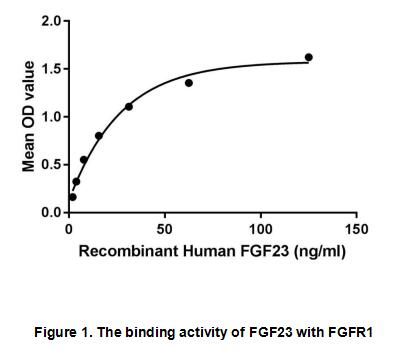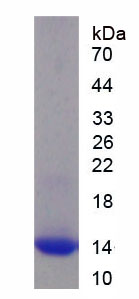
Details
ACTIVITY TEST
Buffer Formulation PBS, pH7.4, containing 0.01% SKL, 5% Trehalose. Traits Freeze-dried powder Purity > 95% Isoelectric Point 7.2 Applications Cell culture; Activity Assays.

Fibroblast growth factor 23 or FGF23 is a member of the fibroblast growth factor (FGF) family which is responsible for phosphate and vitamin D metabolism. The main function of FGF23 seems to be regulation of phosphate concentration in plasma. FGF23 decreases the reabsorption and increases excretion of phosphate and suppress 1-alpha-hydroxylase, reducing its ability to activate vitamin D and subsequently impairing calcium absorption. Besides, Fibroblast Growth Factor Receptor 1(FGFR1) has been identified as an interactor of FGF23, thus a binding ELISA assay was conducted to detect the interaction of recombinant human FGF23 and recombinant human FGFR1. Briefly, FGF23 were diluted serially in PBS, with 0.01% BSA (pH 7.4). Duplicate samples of 100µl were then transferred to FGFR1-coated microtiter wells and incubated for 2h at 37℃. Wells were washed with PBST and incubated for 1h with anti-FGF23 pAb, then aspirated and washed 3 times. After incubation with HRP labelled secondary antibody, wells were aspirated and washed 3 times. With the addition of substrate solution, wells were incubated 15-25 minutes at 37℃. Finally, add 50µL stop solution to the wells and read at 450nm immediately. The binding activity of FGF23 and FGFR1 was shown in Figure 1, and this effect was in a dose dependent manner.
USAGE
Reconstitute in 10mM PBS (pH7.4) to a concentration of 0.1-1.0 mg/mL. Do not vortex.
STORAGE
Avoid repeated freeze/thaw cycles. Store at 2-8°C for one month. Aliquot and store at -80°C for 12 months.
STABILITY
The thermal stability is described by the loss rate. The loss rate was determined by accelerated thermal degradation test, that is, incubate the protein at 37°C for 48h, and no obvious degradation and precipitation were observed. The loss rate is less than 5% within the expiration date under appropriate storage condition.
Image

Figure. SDS-PAGE
Partial purchase records(bought amounts latest0)
User Comment(Total0User Comment Num)
- No comment


 +86 571 56623320
+86 571 56623320




